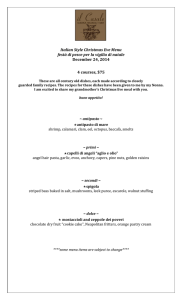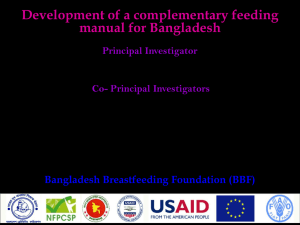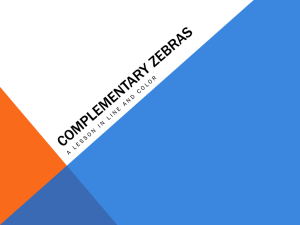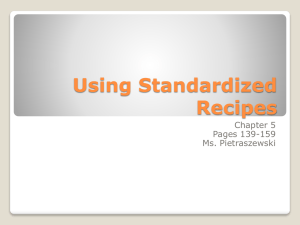Development of a complementary feeding manual for
advertisement
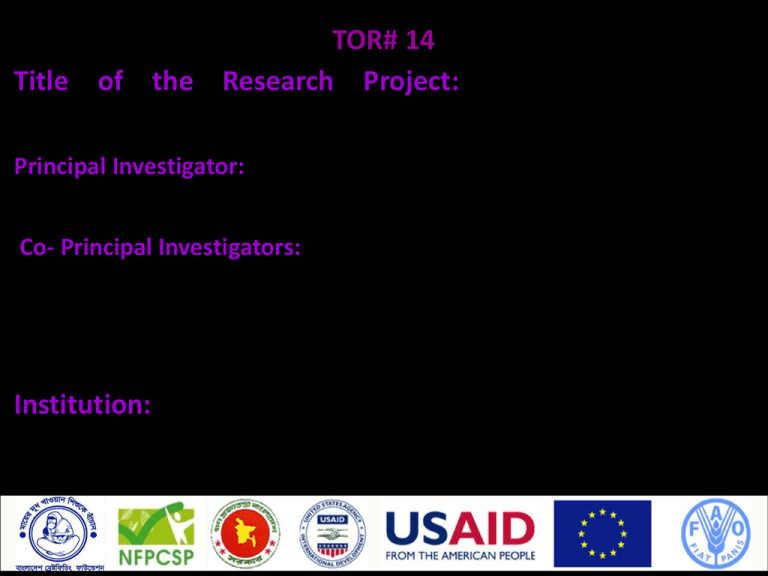
TOR# 14 Title of the Research Project: Development of a complementary feeding manual for Bangladesh Principal Investigator: Dr. A.K.M. Iqbal Kabir, MBBS, MD,PhD, Vice - Chairperson, BBF Co- Principal Investigators: Dr. S. K. Roy, MBBS (Dhaka), M.Sc Nutr, Ph.D (London), FRCP (Edin), Chairperson, BBF And Prof. Soofia Khatoon, MBBS, FCPS (Ped),MHPED (Australia) ,Fellow in Neonatology (U.K), Secretary, BBF Institution: Bangladesh Breastfeeding Foundation (BBF) Context of the study • The exclusive breastfeeding rate is 64% and appropriate CF practices (6-23 months)rate is only 21%. (using the stricter definition as per global guidelines, BDHS-2011) • National guidelines and strategy on CF have been developed (IPHN 2009) • Absence of policy /advocacy tools, particularly a manual on CF recipes using local ingredients and preparation/processing methods). Complementary Feeding Practices (6-23 months) Breastfed Children Non bresatfed Children All Children 80 Percentage of Children 70 64 69 65 60 50 41 40 30 24 25 21 21 15 20 10 0 Minimum Dietary Diversity Minimum Meal Frequency Minimum Acceptable Diet Source: BDHS-2011 Objectives To provide nutrition practitioners and care providers in Bangladesh with necessary guidelines and a recipe manual for improving complementary feeding practices. Objectives 1. To develop a CF guideline to find appropriate feeding practices. Research questions Research Question 1: Is there any documentation and update of complementary feeding practices in Bangladesh? Research Question 2: 2. To assess the dietary and food Is there any assessment of dietary and nutrient diversity and adequacy of adequacy foods complementary foods? methodology /output •Literature review was done by consulting articles on complementary feeding by pub med, Icddr,b library and scientific journal. •Documentation of knowledge and practices on complementary feeding practices, preparation and processing methods, and types of local home based complementary foods used in Bangladesh and in South Asia. Limited data on dietary and nutrient adequacy or nutrient gaps of complementary foods in Bangladesh. •Determination of dietary and nutrient adequacy of complementary foods was done by calculation of selected nutrient values(energy, protein, fat, carbohydrate, vitamin A ,calcium iron, zinc, moisture, ash) using published and unpublished FCT for Bangladesh as well as Regional FCT. 3. To prepare Research Questions 3: •Recipe manual including 35 recipes from nutrient manual of Is there any manual of content. complementary food complementary food •35 recipes were tested in the community for recipes and recipes and acceptability by mothers and their children. complementary complementary feeding •Out of 35 recipes 30 recipes were analyses in a feeding guide. guide? accredited laboratory. Methodology The study used multiple methods, such as analysis of literature Sample frame and Sample Size Qualitative methods Training of staff Baseline survey ------•Focus group discussions •In-depth interview review, focus group Analysis of Data discussion, in-depth interview, technical committee consultations, nutrient analyzing and TIPs (Recipe trial). Stakeholder consultations Development of recipes Recipe trials in seven divisions (Demonstration experience) Manual of CF recipes and CF guidelines Final report Recruitment of staff Qualitative Research: • In-depth interviews with Mothers and fathers :15 • Focus group discussions (FGDs) with the mothers or caregivers and the fathers and the govt. health service providers : 28 • Each focus group discussion included 6-8 persons . • Duration : About 2 hrs • TIPs : Total 35 Recipes were tested for acceptability in seven divisions Result: In depth Interview (Mother) Complementary feeding One third of the mothers started complementary food after completion of six months of age of their child with continuation of breast milk. • Two third of the mothers started Complementary feeding between 7 and 8 months. • They fed their child liquid, semi liquid, semi solid foods like khichuri, semolina (suji), sago, potatoes with pulse and family foods. • One third of them added eggs, chicken, liver, small fish in cooked khichuri. The children were fed 3 to 4 times a day. In Cox’s Bazar, Chittagong division, one mother said, “buker dudh akhono khay, shal dudh dichi, shal dudh dile bachchar valo hoy, shorir, haddi pusto oi, brain valo oi, sastho valo oi.” (I still breastfeed my child, I also fed colostrum. Colostrum is good for health and also for bone and brain development ) Focus Group Discussion (Mother) • Two third of the mothers had little/lack of knowledge on complementary foods, how to prepare and how much should be given to the children. • Half of them thought they gave appropriate diets to their children. • One third of mothers said that they heard about complementary food from their Didi (health worker) or other elder persons like mothers and sisters . • Half of them heard about complementary food from health care centre but did not get any advice on the type of food, frequency of feeding and/or amount needed daily . Assessing dietary diversity and adequacy of CF foods: • To identify the nutrient adequacy, we analyzed some recipes from the field during in-depth interview and FGD. • The assessment showed that energy density was low and did not have required nutritive value and proportion of nutrients. • Such foods often fill the child’s stomach but provide less energy and nutrients , thus contributing to growth faltering. Complementary foods given to children frequently do not provide required amount of energy and nutrients. • The assessment showed that feeding practices and dietary diversity were generally inadequate. For example: Name of the Recipes Khichuri Suzi Age group (months) Weight per serving (g) 6-8 Total energy (Kcal) Per serving 110 Energy density (kcal/g) Nutrient value 125 0.88 55 9 36 12-23 142 125 0.9 92 5 3 (% ) CHO Pro Fat Ingredients Dietary diversity (Type of food) Rice, 3 Lentil, Oil Milk, 2 Suit,Sugar Steps for Development of Recipes Principles : •The formulation of recipes was based on foods used by mothers and the assessment of nutrient gap was done from baseline study. • Factors for assessing nutrient adequacy of recipes considered energy density, nutrient density, protein content, use of micro nutrient rich foods, animal foods, serving size, number of times fed, age of the child, consistency, cost, feasibility, accessibility and seasonality following standard guidelines. (WHO/UNICEF - 2003) Recipe development: 1. Selection of potential foods: Based on field experience selected criteria were followed in developing recipes for children aged 6 to 23 months : Availability, feasibility, nutritive value, cost, acceptability. 2. Potential food combinations (adapted from F AO, Food –based strategies to meet the challenges of micronutrient malnutrition in the developing world) 1. Cereal+ Animal food (fish/ egg/ meat/ chicken/liver) + vegetables+ adequate quantity of oil 2. Cereal + pulse +nuts +vegetable/fruit + adequate quantity of oil 3. Cereal + nuts/fish/egg +fruit/vegetable + adequate quantity of oil 4. Cereal + pulse + Fruit/vegetable + adequate quantity of oil 5. Cereal + pulse + animal food (egg/ liver/ chicken) + vegetable+ oil 6.Cereal + milk/egg + sugar/ molasses + fruit/vegetable Category Name of the recipe Age group Category 1 Pumpkin soup 6- 8 months Chirar polao; Chicken chop; Small fish chop(kachki); Liver Chop 9-11 months Sago aloor bora, vegetable omelet 12-23 months Vegetable khichuri 6-8 months Vegetable chapri,Pusti Gura,Buter Halwa 9-11 months Sweet potato Halwa 12-23 months Category 3 Egg suji, 6-8 months Cereal +nuts/fish/egg+ fruit /vegetables+ adequate quantity of oil Bread toast, Tomato soup, Fish with vegetable & White sauce 9-11 months Fruit pitha, pumpkin coconut halwa, Fish cutlet, 12-23 months Cereal+ Animal food (fish/ eggs/ meat) + green leafy vegetables+ adequate quantity of oil Category 2 Cereal + pulse +nuts +vegetables/fruits + adequate quantity of oil Category Name of the recipe Age group Category 4 Papaya halwa; 6-8 months Cereal + pulse + Fruit/vegetables + adequate quantity of oil mixed vegetable pitha, soya chop 12-23 months Category 5 chicken khichuri, liver khichuri 6-8 months Cereal + lentil + Animal food (chicken/egg )+ fruit / vegetables + oil Vegetable chop 9-11 months Vegetable roll, Egg khichuri 12-23 months Fruit firni; Mango payesh;; Fruit faluda; Pumpkin payesh 6-8 months Sujir halwa; Carrot Laddo Sujir Malpoa; Pudding 9-11 months 12-23 months Category 6 Cereal + milk/egg + sugar/molasses+ fruit/vegetables Trials of improved practice(TIPs): Testing improved recipes for use (Demonstration): •The Complementary foods, recipe options, guidelines, key nutrition education messages and recommendations were based on Trials of Improved Practices (TIPS) carried out in Bangladesh. •For the recipe trials, cooking sessions and sensory evaluations were conducted with mothers. •The recipes were tested for acceptability by young children by observing intake . Examples of the most acceptable recipes Fruit firni (foler payesh) Buter halwa Egg suji (dimer suji) Chicken Chop (Murgir chop) Sujir (semolina)Malpoa Small fish chop (Kachki macher chop) Fruit Pitha (foler pitha) Vegetable roll (Sobji roll) Soya Chop Vegetable chop (sobji chop) Fish Cutlet (Macher chop) Carrot laddo (gajorer laddo) Acceptability (100%) of different recipes by children (Division wise) Fruit firni Buter halwa Carrot laddo Fruit pitha Vegetable chop Sujir malpoa Fish cutlet Soya chop Kachki macher chop Vegetable roll Egg suit Chicken chop Laboratory analysis of nutrients: •Analysis of 30 CF has been carried out in an accredited laboratory. •Analysis of energy, protein, fat, carbohydrate, vitamin A, calcium, iron, zinc, moisture, ash (phosphorus, magnesium, copper) •Out of 35 recipes 30 most commonly used ones were sent for lab analysis. Result on laboratory analysis of some recipes Name of ASH the recipe Liver 1.66% chop Moistur Protei Fats & Energy e n (N X oil (calories) 6.25) 67.27% 5.04% 4.93% 149 Kcal/100g Carboh Zinc (as ydrate Zn) Iron (as Fe) Calcium (as Ca) Vitamin A 21.1% Vegetabl 1.94% e khichuri Egg suzi 0.39% 69.3% 3.81% 5.57% 143 Kcal/100g 19.38% 75.8% 3.16% 3.53% 113 Kcal/100g 17.12% Mixed 1.46% vegetabl e pitha Egg 1.13% Khichuri 72.11% 5.30% 3.54% 123 Kcal/100g 17.59% 78.43% 3.42% 2.7% 95 Kcal/100g 14.32% Fruit firni 63.23% 3.82% 4.4% 165 Kcal/100g 27.44% 1.72 mg/100 g 0.94 mg/100 g 1.22 mg/100 g 1.30 mg/100 g 1.10 mg/100 g 1.24 mg/100 g 42.74 mg/100 g 46.18 mg/100 g 49.66 mg/100 g 57.89 mg/100 g 14.73 mg/100 g 73.95 mg/100 g 64.1 IU/100 g ND <9 IU/ml 100.02 IU/100 g ND <9 IU/ml 73.45 IU/100 g 46.02 IU/100 g 1.11% 0.83 mg/100 g 0.70 mg/100 g 0.44 mg/100 g 0.57 mg/100 g 0.47 mg/100 g 0.56 mg/100 g Recipe composition for different age group Recipe Liver Khichuri Egg khichuri Vegetable khichuri Age group Amount (g) Frequency Total Kcal 6-8 170 2-3 202 9-11 258 3-4 307 12-23 460 4-5 547 6-8 183 2-3 202 9-11 279 3-4 307 12-23 497 4-5 547 6-8 198 2-3 202 9-11 304 3-4 307 12-23 542 4-5 547 % of energy from different nutrients CHO Pro Fat 60 15 25 51 12 37 63 12 25 Cont. Recipe Egg suji Fruit firni Small fish (Kachki) chop Age group Amount (g) Frequency Total Kcal 6-8 171 2-3 202 9-11 260 3-4 307 12-23 463 4-5 547 6-8 167 2-3 202 9-11 126 2 154 12-23 271 3 328 9-11 100 2 204 12-23 160 3 328 % of energy from different nutrients CHO Pro Fat 54 13 33 69 11 20 62 15 23 Comparison between lab result and improved developed recipes Name of the recipe Chirar polao Vegetable chapri Fruit pitha Soya chop Chicken khichuri Pumpkin payesh Nutrient Carbohydrate Protein Fat Energy density Carbohydrate Protein Fat Energy density Carbohydrate Protein Fat Energy density Carbohydrate Protein Fat Energy density Carbohydrate Protein Fat Energy density Carbohydrate Protein Fat Energy density Lab result Calculation by composition table Difference % 59.66 13.6 26.73 1.4 63.27 12.44 24.28 1.72 64.58 9.99 25.43 3.04 58.36 16.3 25.33 1.53 59.5 15.8 24.7 0.95 64.7 9.45 25.85 2.5 58 13 29 1.77 63 11 26 2 65 11 24 3.57 63 14 23 1.87 53 16 31 1.23 68 10 22 1.2 1.66 0.6 -2.27 -0.37 0.27 1.44 -1.72 -0.28 -0.42 -1.01 1.43 -0.53 -4.64 2.3 2.33 -0.34 6.5 -0.2 -6.3 -0.28 -3.3 -0.55 3.85 1.3 Policy Recommendations • The manual and guidelines would serve as a tool for practical knowledge and training for nutrition practitioners, academicians and mothers. • The manual should receive careful attention of government and non-government partners for use/adapting in programs concerned with infant and young child feeding (IYCF). • Formulation of recipes was built on existing practices covering 7 divisions of Bangladesh. • Evaluation of these recipes on biological outcome will be helpful. • There is need for well linked community based programs to build a true multi-sectoral approach. Field Visits in Baseline Field Visits in TIPs
